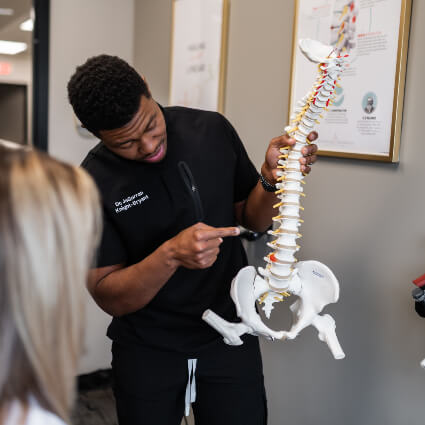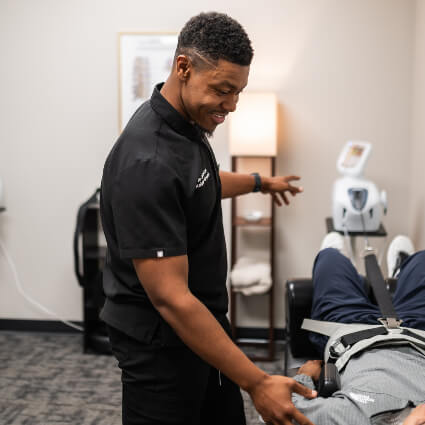Non-Surgical Spinal Decompression in Smyrna
While it’s true that many disc issues occur in the lower back, cervical (neck) disc issues are also a problem many people face. Non-Surgical Spinal Decompression is effective for these cervical disc problems. Helping you get relief without the need for drugs or surgery is our goal at Mustard Seed Chiropractic.
Our Approach
We use the Non-Surgical Spinal Decompression table and technique to provide gentle, safe non-surgical spinal decompression. This technique is performed on a specialized table that has moving pieces, which allow us to create separation between different spinal segments—we’re creating space between the vertebrae through gentle traction. This can help to increase disc height, restore spinal joints to proper alignment and take pressure off of the spine. The result can be reduction or elimination of pain, improved range of motion and greater spinal stability.
It is a non-invasive, type of mechanical traction that utilizes computer technology to gently pull the spine apart taking pressure off the discs, joints, and nerves. It has a built-in feedback sensor that can detect each patient’s tolerance, pain levels, and muscular tension, so it knows when to pull more and when to relax in order to achieve optimal results.
Non-Surgical Spinal Decompression is an affordable and safe treatment for neck and back conditions without the use of drugs, needles, or surgery.
Spinal Decompression Treatment in Smyrna
Prior to beginning a series of Spinal Decompression, patients will be thoroughly examined, and often digital x-rays will be taken. This information helps us to understand the underlying condition of the spine, which spinal discs are compressed, and which treatment protocol will give us the best results.
Most often spinal decompression will be combined with chiropractic adjustments, which together, addresses both the spinal misalignment along with the disc health and nerve pressure. This two-prong approach provides the fastest and longest lasting results and is the best conservative protocol you can possibly do to get the spine in as best shape possible.
While each patients’ condition varies, the standard initial protocol for Decompression Therapy is 24 sessions over 8-12 weeks. Some conditions will require more visits, more frequently; while other conditions require more frequent visits initially then decrease in frequency over time. Each treatment lasts approximately 12 minutes.
On each visit, the patient remains clothed and lies face up comfortably on a motorized table. There is a harness that secures the patient to the decompression table as a pulling type force is applied gently to the spine. There is a series of alternating decompression and relaxation cycles, for an individual treatment time of approximately 12 minutes. The patient typically does not feel pain during or after the decompression visit, although they can feel stretching and lengthening of the spine. Help increase the movement of other nutrient-rich fluids, water, and oxygen into the discs to promote healing.
What Does Spinal Decompression Treat?
Spinal Decompression can be an extremely beneficial treatment option for a variety of reasons, including:

- Herniated Discs – When the disc between your vertebrae is injured and the inner portion moves into the outer portion, this is called a herniated disc. These can be very painful and often times put pressure on the exiting nerve resulting in pain, numbness, or tingling down the arms or legs.
- Bulging Discs – A bulging disc is a disc that has been injured and is protruding out from its normal position. This can cause pain, numbness, and tingling in the affected area.
- Degenerative Disc Disease – Degenerative disc disease is a condition that affects the discs in your spine. The discs can become weak and thin over time, which can lead to pain and other problems.
- Sciatica – Sciatica is when there is a pain in your lower back that sometimes extends down you buttocks and legs. Sometimes this can happen when a person has a herniated disc, bulging discs, or degenerative disc disease.
- Spinal Stenosis – Spinal stenosis is a condition that happens when the spinal column becomes narrower. This can cause problems like pain, numbness, and tingling.
Frequently Asked Questions
Does Spinal Decompression Hurt?
How Many Sessions Will I Need?
A Conservative Approach
Many people believe that the only solution for disc injuries is surgery, but that is not always the case. We encourage people to consider a conservative approach such as Non-Surgical Spinal Decompression first—it may prevent the need for surgery completely.
Contact us today to schedule.
CONTACT US

